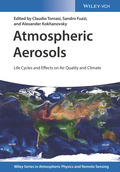Atmospheric Aerosols
Life Cycles and Effects on Air Quality and Climate
Wiley Series in Atmospheric Physics and Remote Sensing

1. Edition January 2017
XXIV, 680 Pages, Hardcover
100 Pictures
Monograph
Short Description
The book describes the morphological, physical and chemical properties of aerosols from various natural and anthropogenic sources to help the reader better understand the direct role of aerosol particles in scattering and absorbing short- and long-wave radiation.
Buy now
Price: 329,00 €
Price incl. VAT, excl. Shipping
Euro prices for Wiley-VCH and Ernst & Sohn titles are only valid for Germany. In EU countries, local VAT applies. Postage will be charged.
A look at the morphological, physical and chemical properties of aerosols from various natural and anthropogenic sources to better understand the role aerosol particles play in scattering and absorbing short and long-wave radiation.
Collating otherwise hard-to-find information, the book provides the in-depth knowledge needed to characterize the microphysical, chemical composition and radiative parameters that are fundamentally important in interactions with incoming solar as well as terrestrial radiation. Particular attention is paid to the indirect aerosol effects on climate occurring within the complex aerosol-cloud-atmosphere system, and the relevant impact of natural and anthropogenic aerosol particles on the air quality and environment, human health and our cultural heritage. A solution-oriented approach is adopted throughout, not only addressing the issues and dangers of these aerosols, but also presenting practicable ways of overcoming them.
Introduction
A General Classification of Aerosol Sources
Primary Aerosols of Natural Origin
Secondary Aerosols of Natural Origin
Primary Anthropogenic Aerosols
Secondary Anthropogenic Aerosols
Global Annual Mass Emission Fluxes of Natural and Anthropogenic Aerosols
NUCLEATION OF ULTRAFINE PARTICLES
Introduction
Principles of New Atmospheric Particle Formation
Chemical and Physical Factors Driving or Inhibiting New-Particle Formation
Occurrence of New-Particle Formation in the Global Troposphere
Importance of Nucleation for the Production of Aerosols and Ccn at the Global Scale
ROLE OF COAGULATION, CONDENSATION, CLOUD FORMATION AND WET AND DRY REMOVAL PROCESSES IN THE ATMOSPHERIC AEROSOL LIFE
Introduction
Physical Growth Processes
Formation of Cloud Particles
Aerosol Sinks (Removal Processes)
CHEMICAL COMPOSITION OF AEROSOLS OF DIFFERENT ORIGINS
Introduction
Global Distributions and Climatologies of the Main Aerosol Chemical Constituents
Size-Distributions of Aerosol Chemical Compounds
Open Questions
MEASURING AEROSOL IN SITU AND REMOTE SENSING
Introduction
Characterization of Aerosol Variables with in-Situ Techniques
Detection of Aerosol Properties by Remote Sensing
Observing Climate Change
NUMBER, SURFACE AND VOLUME SIZE-DISTRIBUTIONS OF AEROSOL POLYDISPERSIONS OF DIFFERENT ORIGINS
Introduction
Concentration and Multimodal Characteristics of the Number, Surface and Volume Size-Distributions of Aerosol Polydispersions
Vertical Profiles of Aerosols from Lidar Measurements
Global Distributions of Aerosols from Satellite-Borne Images
AEROSOL OPTICS
Introduction
Maxwell Theory
Light Scattering and Absorption by Small Solid and Liquid Particles
IMAGE AND RADIATION TRANSFER THROUGH AEROSOL LAYERS
AEROSOL-INDUCED DIRECT FORCING EFFECTS BY NATURAL AND ANTHROPOGENIC AEROSOL
POLYDISPERSIONS
Introduction
Field Measurements of Aerosol Optical Thickness Aot
Characterization of the Aerosol Radiative Properties of Different Origins
Direct Aerosol-Induced Radiative Forcing for Different Particle Polydispersions
THE AEROSOL INDIRECT EFFECTS ON CLIMATE
AEROSOL EFFECTS ON AIR QUALITY THROUGH IN-SITU AND REMOTE SENSING TECHNIQUES
Pollution Due to Natural Sources (Pollen, Desert Dust)
Anthropogenic Pollution
Aerosol Effects on Air Quality
Air Quality from in-Situ and Satellite-Based Measurements
EU and USA Limitations to the Aerosol Emissions and Rules for the Air Quality
IMPACT OF PARTICULATE MATTER (PM) ON THE HUMAN HEALTH
Introduction
Epidemiological Evidences
Toxicological Evidences
Mechanism of Effects
AEROSOL IMPACT ON CULTURAL HERITAGE: DETERIORATION PROCESSES AND STRATEGIES FOR PREVENTIVE CONSERVATION
Introduction
Damage Layers and Black Crusts on Building Materials (Stone-Mortars, Carbonate-Silicate)
Bioaerosol Effects on Cultural Heritage
Monitoring for Cultural Heritage Conservation
Aesthetic Impact on Architectural Surfaces: Implications on Restoration and Maintenance Actions
Future Scenarios
Guidelines for the Preventive Conservation of Cultural Heritage in Urban Areas
He was P. I. from 2005 to 2009 of the national project QUITSAT supported by the Italian Space Agency to evaluate the air quality parameters on the Po Valley area from polar and geostationary satellite-borne observations integrated with ground-based remote sensing and in situ sampling measurements and with Chemical-Transport-Meteorological model simulations of the PM and gaseous concentrations at the surface. Since 2007, he is leader of the international research project POLAR-AOD, dedicated to study the radiative parameters of polar aerosols and their direct radiative forcing effects.
Sandro Fuzzi is Professor of Global Change at the University of Bologna and holds a doctoral degree in Physical Chemistry from the University of Bologna, Italy. He is at present Research Director at the Institute of Atmospheric Sciences and Climate of the National Research Council, CNR. His main research interests are the physical and chemical processes involving atmospheric aerosols and clouds and their effects on atmospheric composition change, climate, ecosystems and human health. Is has been a member of several international Committees and Panels including the Science Panel of the European Commission on Atmospheric Composition Change and the Chairmanship of the International Global Atmospheric Chemistry Project of the International Global Geosphere-Biosphere program. He has coordinated several national and international programs in the field of atmospheric composition change.
Alexander A. Kokhanovsky graduated from the Physical Department of the Belarusian State University, Minsk, Belarus. Alexander Kokhanovsky is a member the SCIAMACHY/ENVISAT algorithm development team at the Institute of Environmental Physics at the University of Bremen. His research interests are directed towards modeling light propagation and scattering in the terrestrial atmosphere. He has published more than 160 papers in the field of environmental optics, radiative transfer, and light scattering.


